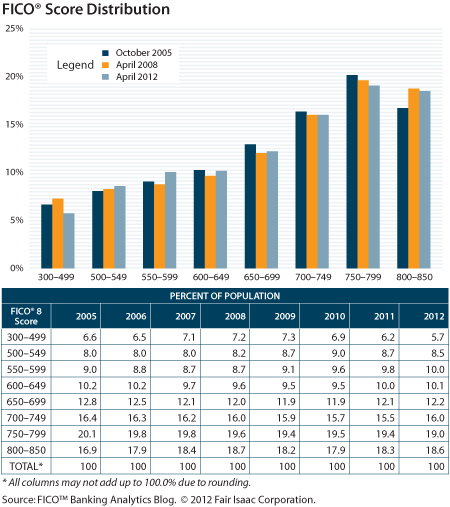FICO® Scores Reflect Slow Economic Recovery
Our FICO Labs team has taken a fresh look at national distribution of FICO® 8 Scores. With a couple of interesting exceptions, we found that consumer scores are continuing their sl…

Our FICO Labs team has taken a fresh look at national distribution of FICO® 8 Scores. With a couple of interesting exceptions, we found that consumer scores are continuing their slow return to a pre-recession pattern.
The first two years of the recession (2008-2009) moved the scores for millions of people into the lowest (300-499) and the highest (800-850) segments of the FICO® Score range. Correspondingly fewer people had scores in the middle range (600-749). In an earlier post, I explained why these separate shifts happened.
This flattening of the distribution curve peaked in 2009-2010 and has since slowly been reversing. However, the latest numbers suggest two unusual patterns in this recovery. First, the quantity of people with very low scores has continued to drop and is now well below pre-recession volumes. In 2005, 14.6% of consumers had scores at the bottom of the score range (300-549). In 2012, the corresponding figure is 14.2%, which is 0.4% lower. This means that about 800,000 fewer people have such low scores today.
At the highest part of the score range (800-850), we see a similar pattern. Since 2010, the quantity of people in this range has continued to increase instead of returning to pre-recession levels. The percentage of people (18.6%) in this scoring segment is now 0.7% higher than it was in 2010, representing approximately 1.4 million more people.
What’s going on here? We don’t have enough data to know for sure. But if I were to speculate, I would suggest that both trends reflect the severity of the recent recession. At the low end of the score range, while some borrowers improved their financial habits and began realizing better scores, many others have likely dropped out of the credit market entirely.
At the high end of the score range, I suspect that large numbers of people continue to protect their finances by doing things such as limiting their revolving debt and postponing new purchases that would require financing. Although people in this group likely could meet today’s demanding standards and qualify for new credit, they seem to be less interested in new debt. And it’s possible they will remain on the sidelines until the economic waters look safer.
FICO’s analysis of the FICO® Score distribution was based on a nationwide sample of consumer credit data from Equifax. FICO estimates that 200 million US consumers have sufficient credit history on file at national credit reporting agencies to calculate a FICO Score.
Popular Posts

Business and IT Alignment is Critical to Your AI Success
These are the five pillars that can unite business and IT goals and convert artificial intelligence into measurable value — fast
Read more
FICO® Score 10T Decisively Beats VantageScore 4.0 on Predictability
An analysis by FICO data scientists has found that FICO Score 10T significantly outperforms VantageScore 4.0 in mortgage origination predictive power.
Read more
It’s 2021. Do You Know What Your AI Is Doing?
New "State of Responsible AI" report from Corinium and FICO finds that most companies don’t—and are deploying artificial intelligence at significant risk
Read moreTake the next step
Connect with FICO for answers to all your product and solution questions. Interested in becoming a business partner? Contact us to learn more. We look forward to hearing from you.

